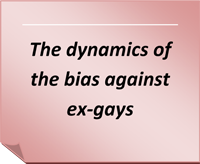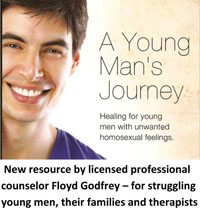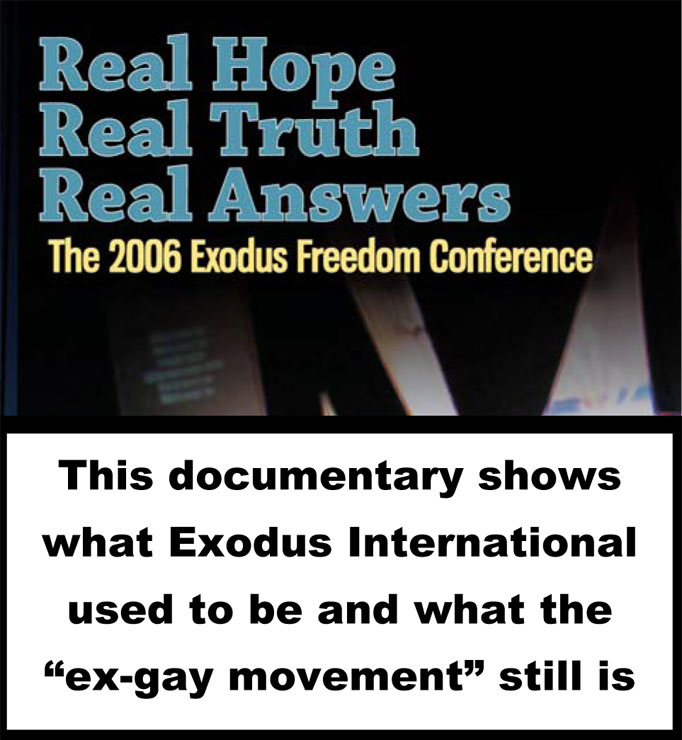Homosexuality – Academic Intro
Free PDF Version of Article
By Thomas Coy
2008
Introduction
When young adults take their education to the collegiate level their psychology textbooks tell them that the American Psychiatric Association (APA) removed homosexuality from its list of diagnostic disorders in 1973. Students are given information about homosexuality from a gay activist point of view. They are told efforts to change homosexuality have failed and that homosexuality is probably the result of biological factors.
America’s Judeo/Christian norms that condemn homosexuality and promiscuity are considered backward and outdated by academia. Many liberal scholars cite the ancient Greek civilization of Plato as an example of an enlightened society that embraced homosexuality as well as promiscuity. Academia now promotes a new politically inspired disorder called “homophobia,” which is used to stigmatize all who still believe that homosexuality is a disorder or involves an immoral lifestyle.
I contend that students and adults are only getting half the information needed to make an informed opinion on homosexuality. This booklet presents some of that other half that academia has chosen to ignore.
Sexual Orientations
A good clinical and scientific definition of sexual orientation is a person’s choice of sexual object. The choice involves ones uncontrolled sexual attractions as well as ones sexual behavior. There are many sexual orientations and they are changeable, but not easily changed. The more common sexual orientations include heterosexuality, homosexuality, bisexuality, pedophilia, pederasty, bestiality, and fetishism. From this definition, most people agree that discrimination should be based on sexual orientation. However, modern society disagrees on which sexual orientations should be encouraged and which should be discouraged.
Generally speaking, the Judeo/Christian norm of sexuality encourages only the heterosexual orientation and fidelity within marriage, while the liberal pro-gay norm of sexuality encourages homosexual, bisexual, and heterosexual orientations, and consensual promiscuity along with consensual fidelity. There are also sexual minorities that encourage the sexual orientations of pedophilia, pederasty, bestiality, and fetishism.
Sexual Orientation Can Be Changed
My research of homosexuality has found that efforts to change homosexuality, both before 1973 and into the twenty-first century, have been successful. Leading psychologists and psychiatrists before 1973 reported that 25 to 50 percent of their patients who sought their help successfully changed their homosexual orientation to heterosexual. In 1965 Judd Marmor, M.D., a psychiatrist influential in the removal of homosexuality from the APA’s list of diagnostic disorders, acknowledged these success rates.
Today a prominent psychologist in reparative therapy, Joseph Nicolosi, Ph.D., reports that about 30 percent of his homosexual patients achieve a change in their sexual orientation. Exodus International reports similar results in many of their affiliate ministries where former homosexuals are able to remain abstinent or change their sexual orientation. Both Nicolosi and Exodus International report that an additional 33 percent of homosexuals who seek their help say they benefited from their treatment and programs even though their sexual orientation did not change. The remaining third report little or no benefit from their efforts.
Because the success rate for homosexuals seeking to change their sexual orientation is not 100 percent, it is criticized by gay activists and their supporters. However, a 30 percent success rate for psychotherapy is significant. The success rates for homosexuals seeking to change their sexual orientation are actually better than several psychoanalytic success rates I found for treating alcoholism and smoking. Common sense tells us that sexual orientation should only be viewed clinically as a changeable behavioral condition and not an innate human characteristic like race or gender, because race and gender cannot be changed through psychotherapy.
Biological Bisexuality, Genetics, and Hormones
In 1940 the Freudian hypothesis that humans were in some way biologically bisexual was put to rest by Sandor Rado, M.D. Rado pointed out that humans are born with either male or female genital organs, and in the cases of hermaphrodites with elements of both genital organs, the malformation “impedes or destroys one form of reproductive functioning while creating no new capacity to function in the opposite way.”
The known knowledge before 1973 showed that genetics and hormones were not the cause of homosexuality. Despite many efforts to find a gay gene as well as a link between hormones and homosexuality, current research has found no defining link or gay gene.
Those treating homosexuals, in an effort to change their sexual orientation, postulate that genetic predispositions probably contribute to homosexuality. In the documentary Melissa Coffey mentioned that possibility. Some of the most agreed upon possibilities are genetic predispositions that make a person more sensitive, introverted, and timid. These predispositions could cause a child to perceive rejection and feelings of inferiority when there is no legitimate basis for those feelings. They could also inhibit a child in many other ways. The childhood testimony of Chris Stump in the documentary revealed how deeply he felt rejected by his father when his father would not play with him. Similarly, there may be a genetic predisposition that causes a male child to prefer artsy activities over athletic activities. That in turn could cause friction in same-sex child play leading the child to think this characteristic makes him less masculine, which could be further reinforced by peers, teachers, and even parents.
Psychological Factors
Sandor Rado, M.D. (1940) introduced the concept that homosexuality was a reparative adjustment to anxieties related to rejection and sexual identity crises from early childhood. Irving Bieber, M.D. (1962), Charles Socarides, M.D. (1968), and Lawrence Hatterer, M.D. (1970) all agreed with Rado on that point and believed each individual’s homosexuality was unique in its combination of causal factors. The most common combination of causal factors they saw in male homosexuals seeking help was a close bonding relationship between the patient and their mother coupled with a distant or weak father. Their typical male homosexual patient never separated his gender identification from his mother in early childhood when a normal boy transfers his identity to his father. Often times the mother substituted the lack of emotional intimacy in her marriage relationship with an emotionally intimate relationship with her son. Medical professionals in the twenty-first century that treat male homosexuals desiring to overcome homosexuality have also found these circumstances to be the most common causal factors of male homosexuality, but certainly these are not the only combinations causing male homosexuality.
The most surprising cause of homosexuality that I have found I learned from the testimonies of men who felt mixed emotions when they were sexually molested as a child or adolescent. Boys who have no father or who feel rejected by their father and their peers are targets for sexual predators, because boys desire affirmation from men and their peers. When a boy is sexually molested the abuser can arouse and sexually stimulate the boy, causing the boy to experience an erection and possibly orgasm. The molested boy becomes very confused over feeling sexual pleasure from the abuser and when he learns what homosexuality is, he figures that he must be a homosexual, because he experienced some pleasure from the abuse. In the documentary James Wimbush’s testimony illustrates the confusion and consequences that came from his childhood sexual abuse.
The scenario is generally different when a girl is sexually molested. The girl is generally hurt and experiences pain from sexual penetration. In contrast to the sexually molested boy, the girl often rejects men, because they represent pain, fear, violation, and terror. Those who work with lesbians bear witness that a significantly high number of lesbians were sexually molested by men.
Keys for a Successful Sexual Orientation Change
The early pioneers of treating homosexuality to effect a change in sexual orientation all claimed the patient’s motivation was the most important factor for success. Today, psychotherapists also stress motivation as the key ingredient. Motivational reasons range from religious beliefs to disillusionment with the gay lifestyle, and often a combination of both. Exodus International is an organization of individuals with these motivations.
Other characteristics making sexual orientation change more probable are a prior pleasurable heterosexual experience and early treatment. If an adolescent seeks treatment before he/she acts out on their same sex attractions, the probability of a sexual orientation change is greater. In general, the more years an individual is sexually active in homosexual behavior the harder it is to change sexual orientation.
This clinical observation corresponds with the scientific knowledge of how the brain works in relation to behavior. Habits of behavior create patterns in the brain that cannot be erased. Patterns with rewards of sexual orgasm or a euphoric drug rush become particularly strong. Research has shown that over an extended period of time certain patterns of behavior change parts of the brain. Whether a person wants to overcome extended pornography use, drug use, or an aberrant sexual deviation like homosexuality, new patterns of behavior have to be built on top of the old patterns in the brain to effect a meaningful change. This is usually a difficult task.
Even after new patterns have been built on top of the old patterns in the brain, unexpected anxieties can trigger memories and stimulate the old patterns. These are the times a drug addict or an alcoholic either goes into a relapse or overcomes the initial temptation. Similarly, a person who overcomes homosexuality will at times have to overcome situations that trigger his/her old patterns. These trigger situations are usually harder to overcome in the initial phases of treatment.
Another key to overcoming homosexuality is the development of healthy same sex friendships. Several testimonies in the documentary emphasize this point. Both Exodus ministries and reparative therapy psychoanalysts encourage homosexuals seeking change to develop non-sexual same sex friendships with heterosexuals. Several important turning points in a homosexual’s life can occur from these friendships. First, healing from same sex rejection can take place like the experience Bryan describes in the documentary. Second, these same sex friendships are the first step in the process of diminishing same-sex attractions. As the homosexual develops these non-sexual friendships and becomes one of the guys/gals, his/her identity changes. The male no longer identifies as a homosexual, but rather as a man, and the female no longer identifies as a lesbian, but as a woman. As the ways of men become less mysterious and normal to the male homosexual, the ways of women start to appear more mysterious. It is at this point that many male homosexuals start to become attracted to the opposite sex, which is the beginning of a change in sexual orientation.
What Happened in 1973?
The psychiatrists who treated homosexuality as a disorder in 1973 were blindsided by the decision of the American Psychiatric Association trustees to remove homosexuality from its list of diagnostic disorders. They thought that their documented success rates and evidence of pathological parent-child relationships would win out over the gay influence in the APA. They were wrong.
Gay activists disrupted APA meetings for three years leading up to the 1973 vote and were rewarded for their efforts with special APA lobbying access. The trustees of the APA voted to remove homosexuality from the list of diagnostic disorders on the recommendation of a Nomenclature Committee that had no medical experts on homosexuality. This Committee actively sought the input of gay activists, while disregarding the psychiatrists who were the experts in treating homosexuality as a disorder. While the Committee consulted with leading gay activists, they never inquired the viewpoints of homosexuals who desired to change their sexual orientation.
Dissenting psychiatrists charged that the trustee decision was political and ignored the scientific facts. Using the only option available to them they organized a petition effort demanding the change in nomenclature be brought to a vote of the entire APA membership. Immediately, the National Gay Task Force raised funds to purchase the APA mailing list and sent out over thirty thousand letters to members of the APA urging them to approve the removal of homosexuality from the list of diagnostic disorders. The letter was signed by several prominent psychiatrists and purposely did not indicate that it had been partly written by the National Gay Task Force, nor did it acknowledge that the mailing was paid for by the National Gay Task Force.
Approximately thirty-three percent of the membership responded to the vote and 58 percent of the respondents approved the ruling to remove homosexuality from the list of disorders. A survey of psychiatrists taken four years after the APA vote showed that 69 percent of the psychiatrists surveyed disagreed with the vote and still thought that homosexuality was a disorder. The gay political movement has used this 1973 nomenclature change as the foundation stone of its effort to dominate opinion on homosexuality in medical associations and in academia.
There were several arguments to support the position that homosexuality was not a mental disorder. These arguments did not dispute the evidence that sexual orientation could be changed. Evelyn Hooker, Ph.D. defended the position that homosexuality was not a mental disorder because she had documented many homosexuals who functioned well in society despite their aberrant sexual behavior. Judd Marmor, M.D. argued that the vast majority of homosexuals did not want treatment to alter their sexual orientation, and that the causative data on homosexuality was only coming from homosexuals who sought treatment, not the ‘normal’ homosexual. Another of Marmor’s arguments was that many heterosexuals had been raised in the same pathological parent-child relationships that were believed to be a cause of homosexuality. He even argued that the possibility existed where one could be trained culturally to accept homosexuality as a preferred choice. The example of ancient Greek society’s acceptance of homosexuality was used again and again by those who believed homosexuality should not be classified as a disorder.
Psychiatrists opposed to removing homosexuality from the list of diagnostic disorders were astounded that functioning normally or the lack of subjective distress was being used as a determinant to rule out psychopathology, because the lack of such distress often revealed a greater depth of psychopathology. Marmor’s causation criticism that many heterosexuals were raised in the same parent-child psychopathological environments as homosexuals was more of a smoke screen. If the same reasoning was applied to other disorders, psychiatry would have to rule out combat experience a causative factor of shell shock, because other soldiers in similar combat environments did not suffer the disorder.
Lastly, both sides of the disorder debate thought that the criminal penalties for being a homosexual were too extreme or entirely wrong. The argument was made that removing homosexuality from the APA’s list of disorders would be a major step toward removing criminal and civil penalties against homosexuals. With the nomenclature change in 1973 the APA made a major philosophical shift. It had chosen to support the interests of a political cause over the interests of the individual patient. A homosexual civil rights resolution written in part by gay activist Ronald Gold accompanied the APA nomenclature change.
Ancient Greece
An examination of the culture in which Plato and Socrates lived has made me wonder why many liberal elites refer to it as an example of enlightened sexual morality. The type of homosexuality that was exalted by ancient Greek culture was not sexual relationships between adult men or between adult women, but sexual relationships between a free man and a free adolescent male. This form of homosexuality is called pederasty. The adult men did not marry the young men. Generally, these men were already married and enjoyed a wide variety of socially acceptable sex including prostitutes, women slaves, and male slaves. Boy slaves were also used for homosexual purposes in Greek society, though some disapproved of this indulgence. The socially acceptable homosexual role of the free man was only as the penetrator, and any effeminate behavior in a man or in an adolescent boy was ridiculed in that culture.
During this period of ancient Greece the pederasty relationships were agreed to by the parents of the adolescent boy. In today’s terms it was the equivalent of a college scholarship, internship, or apprenticeship. The free man provided the training with the understanding that the free adolescent boy would be providing sexual favors. Ideally, from the Greek philosopher’s viewpoint, there was supposed to be an emotional connection of mutual respect between the older man and the young man. When the young man became an adult and completed his training the sexual relationship ended, but the older man was supposed to continue favoring the young man with gifts and friendship. This Greek ideal was a twisted morality at best. The culture disrespected the man who would let another man anally penetrate him, yet encouraged an adolescent boy to submit to sexual anal penetration in prearranged agreements. Gay identified writer’s Marshall Kirk and Hunter Madsen, Ph.D. have argued that the arranged pederasty relationships of ancient Greece should be recognized as the “traditional gay family.”
The status of the wife during the reign of pederasty in enlightened ancient Greece was similar to that of a slave. The wife of a free Greek man had no political or economic rights, except for her dowry. She was excluded from cultural activities and had less influence on her husband than high-class prostitutes. The same Plato that exalted pederasty explained the existence of women as the reincarnation of men that had led lives of “cowardice and injustice.” These were the “enlightened” sexual norms of ancient Greek society during its period of homosexual adulation.
A phenomenon somewhat related to the time of pederasty in ancient Greece occurs in modern American society. Corresponding to the promotion of Grecian pederasty was the action of some parents in ancient Greece to hide their boys from the pederast philosophers – their academic elite. In a similar scenario some parents in today’s society have chosen to home school their children because they do not agree to the teachings in their school district that promiscuity and homosexuality are equal to heterosexual marriage both morally and in quality of life.
The Gay Life
Most of the individuals who seek psychotherapy or Exodus ministries to overcome their homosexuality have found that the gay life is not gay. Gay activists portray the homosexual culture as a mirror image of modern heterosexual culture, with homosexual men and women typically pairing up in same-sex marriage type relationships. That image is good for gay politics, but it does not represent the big picture. Evelyn Hooker, Ph.D., a leading supporter of gay rights, researched the male homosexual community in the Los Angeles area in the 1950s and 60s. She reported that monogamous fidelity in the male homosexual world was rare and that the moral norms of this community welcomed promiscuity. In the United States she insisted that wherever male homosexuals met there was the expectation that sex could be had “without obligation or commitment.” Hooker and others documented that the male homosexual world was more narcissistic than the heterosexual world, putting excessive value on youth and physical attractiveness.
Gay activists Marshall Kirk and Hunter Madsen, Ph.D. wrote in 1989 that male homosexual relationships usually don’t last very long. They argued that too many male homosexual couples are together for sexual convenience. Once the youth and mystery of their sexual relationship is gone they separate, and head back to the sterile bar scenes and one-night stands. In an honest look at the unpleasant side of gay culture Kirk and Madsen chastised their gay counterparts for not being honest, for their rejection of morality, for being sexual predators, for destructive and self-indulgent sexual behavior, for sexual behavior in public places, for narcissistic behavior, and for sexual infidelity in couple relationships. With its emphasis on youth and beauty these gay authors also divulged that the gay community can be especially cold and lonely for the physically unattractive. One does not have to look into the testimonies of ex-gays to find evidence that gay life has been anything but gay for many homosexuals.
The Battle over the Treatment of Homosexuality
Pro-gay political viewpoints are the dominant viewpoints on homosexuality in medical associations, universities, teacher’s unions, and the major media corporations. After fifty years of evidence that homosexual orientation can be changed, the American Psychiatric Association still insists there is no evidence to support the argument that sexual orientation can be changed (http://www.healthyminds.org/glbissues.cfm). This professional organization recognizes the Association of Gay and Lesbian Psychiatrists as an interest group (http://www.aglp.org/), while not recognizing an association of psychotherapists who will help homosexuals change their sexual orientation (www.narth.com). The American Psychological Association has a committee on Lesbian, Gay, and Bisexual Concerns (http://www.apa.org/pi/lgbc/homepage.html), but no committee concerned about those desiring to overcome their homosexuality. Furthermore, the National Education Association policies on homosexuality (http://www.nea.org/schoolsafety/glbt.html) are influenced by and mirror the gay activist organization GLSEN (Gay, Lesbian, and Straight Education Network). University policies are equally biased. Any university that has an official Lesbian, Gay, Bisexual, Transgender (LGBT) department is financing a gay political interest group to influence and dictate its policies on homosexuality. Within these organizations any viewpoints opposed to gay positions are often interpreted as forms of homophobia. This has been a brilliant political strategy for gay activists, but it has removed objectivity from issues of homosexuality.
After years of gay activists dominating the debate on homosexuality several psychologists and psychiatrists formed an organization in 1992 called the National Association for Research and Therapy of Homosexuality (NARTH). Gay interest groups within both the American Psychiatric Association and the American Psychological Association have successfully isolated this organization to this date. The purposes of NARTH include: providing effective psychological therapy to homosexuals seeking change, advocating for the homosexual’s right to have trained medical professionals help them try to change their sexual orientation, continuing the research on the causes of homosexuality, advancing the psychoanalytic treatments to change sexual behavior and orientation through reparative and cognitive methods, and arguing for socio-political diversity within medical associations on issues of sexuality and gender.
To counter the evidence and arguments of NARTH, gay activists claim that efforts to change sexual orientation from homosexual to heterosexual are harmful. Gay activists have successfully sold their harm theory and have pushed for resolutions that would ban APA members from helping homosexuals change their sexual orientation. NARTH and Exodus International refute the accusations of harm and question what qualifies as harm. If disappointment is harm, then every effort to change behavior ending in disappointment is harmful. A recent longitudinal study on sexual orientation change achieved through the Exodus ministries was conducted by Stanton L. Jones, Ph.D. and Mark A. Yarhouse, Psy.D. It found “no meaningful evidence that the attempt to change sexual orientation through the Exodus ministries causes harm.”
It has long been documented that homosexuals as a group have significantly higher suicide rates and higher rates of pathological behavior. Gay activists continue to argue that society’s discrimination against homosexuals is the cause of this high rate of self-destructive behavior. Medical professionals who treat homosexuality as a disorder acknowledge that society’s disfavor of homosexuality could cause some self-destructive behavior, but they believe the high rates are predominantly caused by the pathological causes of homosexuality. They believe that the higher rates of unresolved childhood aggression toward a mother or father, and the higher rates of sexual abuse reported among homosexuals are the probable cause of the higher rates of self-destructive behavior.
From my perspective as a researcher, parent, and grandparent, the most significant advancement in the treatment of homosexuality coming from NARTH has been Joseph Nicolosi’s advancement in the prevention of homosexuality. Nicolosi has identified characteristics and behavior in children that put them in a category he labels as prehomosexual. The term and concept was initially developed in the 1960’s by Irving Bieber, M.D. By educating and teaching parents how to help the child identify with its own gender, the vast majority of prehomosexual children can be guided to a heterosexual orientation. In the case of an effeminate boy the mother is usually encouraged to spend less time with the boy and to persuade the boy to spend more time with his father. The father has to find what interests the boy and spend more time with the boy encouraging and mentoring his interests. Parents are also coached to put the boy in activities with other boys where he will be accepted and feel that he is like the other boys. The parent’s goal becomes helping the boy identify as a boy and creating his desire to identify as a man. Gay activists condemn this advancement in the prevention of homosexuality. The gay viewpoint is that a child should be left alone to develop his or her sexual orientation. Nicolosi’s advancement in the treatment of the prehomosexual child has not been recognized by the medical associations and academia.
The Conflict within the Church
There are many conflicts going on within the Christian church over the issue of homosexuality. The gay political movement demands that the Christian church welcome and affirm homosexuals. Christians opposing the gay political movement also agree that the Christian church must welcome and affirm homosexuals, but they have different meanings for welcome and affirm.
The form of affirmation that gay activists seek is the affirmation that homosexual behavior is not sin. Therefore, the welcome the gay activist demands is for individuals who openly engage in homosexual behavior to be allowed membership and positions of authority within a church.
The evangelical Christian offers the homosexual the affirmation that when a homosexual repents of his sin (including homosexual behavior) and follows Christ, all of his sin is covered by the blood of Christ. The evangelical Christian acknowledges himself as a repentant sinner and welcomes the repentant homosexual into the fellowship of repentant sinners. In general all repentant sinners and followers of Christ are allowed membership in a Christian church and the opportunity to seek positions of authority. These two perspectives on homosexuality use the same words with different meanings that are irreconcilable.
The Exodus message concerning sin is compassion without comprise of biblical principles. They stand on the biblical principle that homosexual behavior is sin, but offer the compassion and hope that Jesus showed to sinners. A major theological point Exodus brings to the discussion is that a person’s same-sex attractions are not sin. Homosexual behavior and lust are viewed as sin, but not the attractions that they have not chosen. That is a message they continually take to churches that have traditionally condemned both the attractions and behavior.
Many who have sought freedom from homosexuality have been rejected by church folk that have not known how to help them or refused to recognize their cry for help. Exodus is a model of how the Christian church can reach out to those seeking freedom from biblically sinful behavior. Their ministries walk with individuals through their journey to change and stress the importance of the church in providing healthy same-sex friendships.
The Exodus message to those with loved ones living a gay lifestyle is also a model for the Christian church. Exodus counsels parents and friends to continue to love and communicate with their loved ones caught up in homosexuality. Carrie’s interview in the documentary illustrates that Exodus message to parents.
Part of the gay political movement’s offensive on American culture has been the creation of gay revisionist theology. Beneath all the rhetoric the bottom line remains whether or not the Bible labels homosexual behavior as sin. Leviticus 18:22 is the most direct condemnation of homosexual behavior in the Bible and dates back to the Law of Moses. An objective search of scripture, like Christopher Yuan’s in the documentary, has led many gay identified individuals to reject their homosexuality.
Instead of focusing on the theological arguments, I would like to share a biblical scripture that I have heard referenced several times by those who have found freedom from homosexuality. I Corinthians 6:9-11 reads, “Do not be deceived: Neither the sexually immoral nor idolaters nor adulterers nor male prostitutes nor homosexual offenders nor thieves nor the greedy nor drunkards nor slanderers nor swindlers will inherit the kingdom of God. And that is what some of you were. But you were washed, you were sanctified, you were justified in the name of the Lord Jesus Christ and by the Spirit of our God.” This scripture carries two powerful messages to those seeking to overcome homosexuality. First, it shows that homosexual behavior is no worse than the other sins listed and that Christ’s sacrifice on the cross covered the sin of homosexual behavior. Second, the last half of the scripture indicates that some in the early Christian church had been involved in homosexual behavior and no longer were. To those seeking sexual behavior change it is very affirming to know that two thousand years ago people were finding freedom from homosexuality through Jesus Christ.
Conclusion
It is mind boggling that at the beginning of the twenty-first century NARTH and Exodus are in a battle defending the right of individuals to have medical professionals help them change their sexual orientation. The medical associations and academia continue to promote the tenets of the gay political movement even when the facts show the tenets are lies at worst and debatable at best. The extent to which this adoption of gay tenets represents contempt of Judeo/Christian morality is unclear, but it is evident that contempt plays a factor.
Many within NARTH and Exodus can verify that gay activists and their advocates, who profess tolerance as their moral foundation, have little tolerance for them. If you have seen the documentary, you have witnessed the essence of an Exodus Conference. Gay activists usually protest these events labeling them both hateful and harmful to homosexuals. In actuality Exodus conferences are only harmful to the gay political movement. The conferences seem to offer what gay activists fear most – Real Hope – Real Truth – Real Answers.
Copyright 2008
Websites containing academic information ignored by liberal academia
www.narth.com
www.acpeds.org
www.drthrockmorton.com
www.homosexuality101.com
Religious based organizations helping individuals overcome homosexuality
www.exodus.to – Christian
www.couragerc.net – Catholic
www.evergreeninternational.org – Mormon
www.jonahweb.org – Jewish
www.ha-fs.org – Christian




